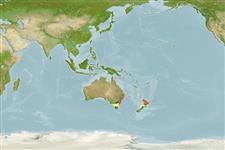Teleostei (teleosts) >
Scombriformes (Mackerels) >
Scombridae (Mackerels, tunas, bonitos) > Scombrinae
Etymology: Sarda: Latin and Greek, sarda = sardine; name related to the island of Sardinia (Ref. 45335).
More on author: Macleay.
Environment: milieu / climate zone / depth range / distribution range
Ecology
Marine; pelagic-neritic; oceanodromous (Ref. 51243). Subtropical; 23°S - 48°S, 141°E - 180°E (Ref. 168)
Southwest Pacific: southeastern Australia, Norfolk Island and New Zealand.
Size / Weight / Age
Maturity: Lm ? range ? - ? cm
Max length : 180 cm FL male/unsexed; (Ref. 40637); common length : 45.0 cm FL male/unsexed; (Ref. 168); max. published weight: 9.4 kg (Ref. 168)
Dorsal spines (total): 17 - 19; Dorsal soft rays (total): 13 - 18; Anal spines: 0; Anal soft rays: 14 - 17; Vertebrae: 45 - 46. Mouth moderately large. Interpelvic process small and bifid. Swim bladder absent. Laminae of olfactory rosette 21 to 39. Spleen large and prominent in lateral view. Liver with elongate left and right lobes and a short middle lobe. Body completely covered with very small scales posterior to the corselet. Dorsal stripe closer to being horizontal than in other species of Sarda and extending up to the belly in some specimens.
Schooling by size and maturing from January through April. Flesh is light-colored of delicate flavor and good canning quality.
Life cycle and mating behavior
Maturities | Reproduction | Spawnings | Egg(s) | Fecundities | Larvae
Collette, B.B. and C.E. Nauen, 1983. FAO Species Catalogue. Vol. 2. Scombrids of the world. An annotated and illustrated catalogue of tunas, mackerels, bonitos and related species known to date. Rome: FAO. FAO Fish. Synop. 125(2):137 p. (Ref. 168)
IUCN Red List Status (Ref. 130435)
Threat to humans
Harmless
Human uses
Fisheries: minor commercial; gamefish: yes; bait: usually
Tools
Special reports
Download XML
Internet sources
Estimates based on models
Preferred temperature (Ref.
123201): 13.9 - 19.7, mean 14.9 °C (based on 107 cells).
Phylogenetic diversity index (Ref.
82804): PD
50 = 0.5312 [Uniqueness, from 0.5 = low to 2.0 = high].
Bayesian length-weight: a=0.00955 (0.00464 - 0.01966), b=3.05 (2.88 - 3.22), in cm total length, based on LWR estimates for this (Sub)family-body shape (Ref.
93245).
Trophic level (Ref.
69278): 4.5 ±0.80 se; based on food items.
Resilience (Ref.
120179): Low, minimum population doubling time 4.5 - 14 years (Preliminary K or Fecundity.).
Fishing Vulnerability (Ref.
59153): Very high vulnerability (90 of 100).
Nutrients (Ref.
124155): Calcium = 25.3 [13.7, 43.2] mg/100g; Iron = 2.22 [1.25, 3.92] mg/100g; Protein = 20.9 [19.7, 22.0] %; Omega3 = 0.327 [0.152, 0.685] g/100g; Selenium = 36.4 [17.6, 64.6] μg/100g; VitaminA = 11.4 [4.3, 32.7] μg/100g; Zinc = 0.386 [0.286, 0.581] mg/100g (wet weight);
